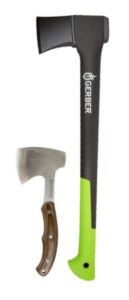From cutting firewood to pounding tent stakes to hacking through a rib cage, there’s a place in every elk camp for a trusty axe or hatchet. While they might be cumbersome to pack on your back, you can always use a hardy all-purpose blade in camp. We’ll take you through the basics and benefits of the camp axe and hatchet.
Old World Meets New
 The Swedes know their axes, and Gransfors Bruks has been building some of the best since 1902. The Scandinavian Forest Axe, pictured here, is ideal for felling and limbing poles for a wall tent. Its hand-forged head and hickory handle make it light enough to swing all day.
The Swedes know their axes, and Gransfors Bruks has been building some of the best since 1902. The Scandinavian Forest Axe, pictured here, is ideal for felling and limbing poles for a wall tent. Its hand-forged head and hickory handle make it light enough to swing all day.
 A new-age twist on a classic idea, Gerber’s 23.5” Axe certainly takes some of the maintenance out of a traditional axe by building a handle out of glass-filled nylon. That synthetic handle provides a sticky grip if you’re splitting in the rain.
A new-age twist on a classic idea, Gerber’s 23.5” Axe certainly takes some of the maintenance out of a traditional axe by building a handle out of glass-filled nylon. That synthetic handle provides a sticky grip if you’re splitting in the rain.
Pack Axe
If you’ve ever split kindling with a full-size axe, you’ll immediately appreciate the balance of a pack axe. Use it as a hammer, limbing tool or rib cage splitter. CRKT’s lightweight Birler is a solid choice.
The lightest, sleekest and most basic blade in our line-up is the Browning Elk Camp Axe. Its slim profile means it can be easily used as a skinning tool and still finesse those backstraps out. With a $50 donation to the RMEF, it can be yours. Go to rmef.org/campaxe.
Sharpening an axe
Step 1: Use a file to remove any nicks in the blade. Be sure to maintain the original angle of the bevel.
Step 2: Using a grinding stone in a circular motion, restore the edge, first with coarse grit, then fine.
Step 3: To remove any burrs, make two or three passes along the edge with a leather strop or belt.